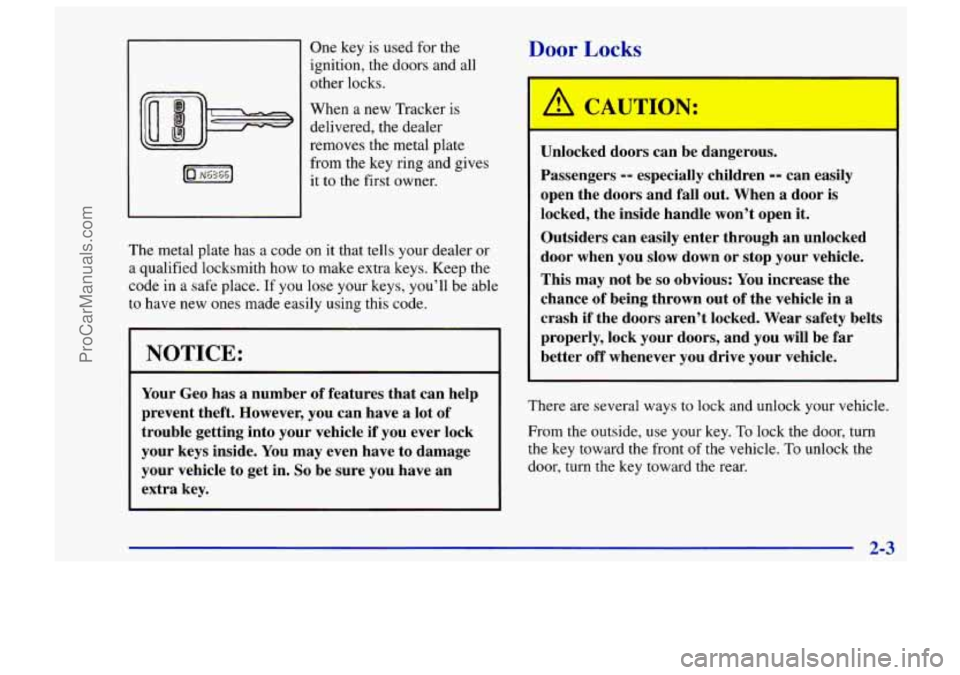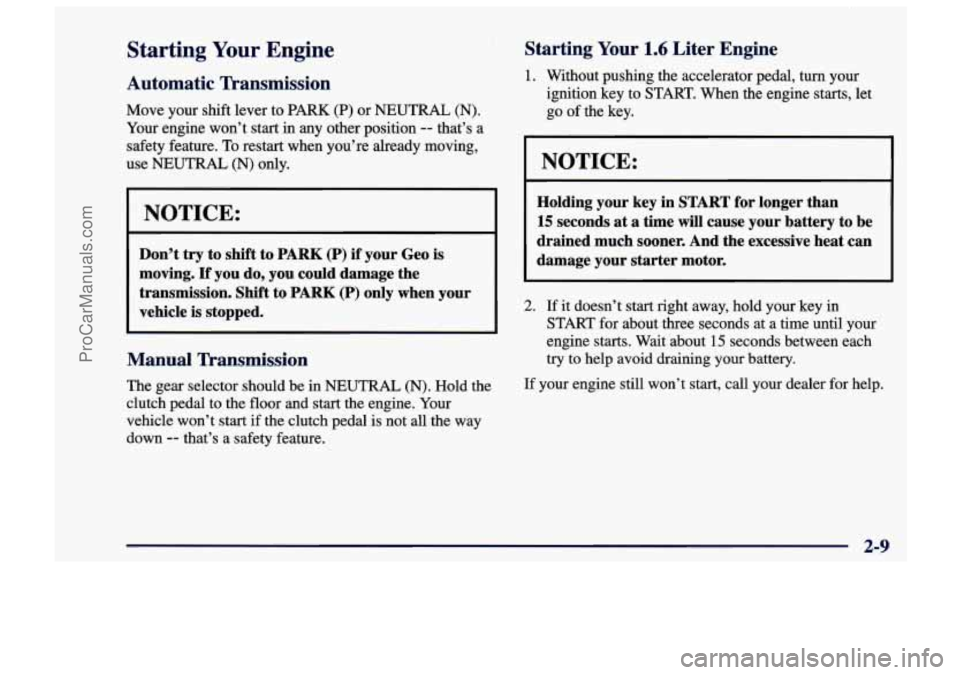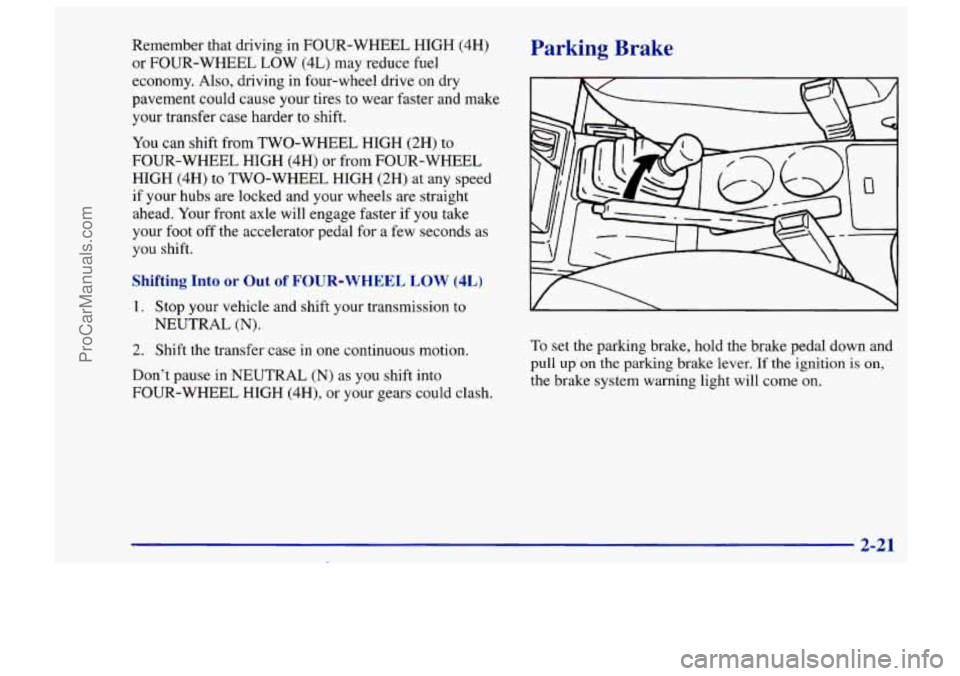ignition CHEVROLET TRACKER 1997 Owners Manual
[x] Cancel search | Manufacturer: CHEVROLET, Model Year: 1997, Model line: TRACKER, Model: CHEVROLET TRACKER 1997Pages: 388, PDF Size: 20.12 MB
Page 38 of 388

0 Your vehicle is equipped with a crash sensing and
diagnostic module, which records information about
the air bag system. The module records information about the readiness
of the system, when the sensors are
activated and driver’s safety belt usage at deployment.
0 Let only qualified technicians work on your air bag
system. Improper service can mean that your air bag
system won’t work properly. See your dealer
for service.
Servicing Your Air Bag-Equipped Geo
Air bags affect how your Geo should be serviced. There
are parts
of the air bag system in several places around
your vehicle. You don’t want the system to inflate while
someone
is working on your vehicle. Your Geo dealer
and the Tracker Service Manual have information about
servicing your vehicle and the air bag system.
To
purchase a service manual, see “Service and Owner
Publications” in the Index.
NOTICE:
If you damage the covering for the driver’s or the
right front passenger’s air bag, the bag may not
work properly. You may have to replace the air
bag module in the steering wheel or both the air
bag module and the instrument panel for the
right front passenger’s air bag.
Do not open or
break the air bag coverings. For up to
15 seconds
after the ignition key is
turned off and the battery is disconnected, an air
bag can still inflate during improper service. You
can be injured if you are close to an air bag when
it inflates. Avoid wires wrapped with yellow tape
or yellow connectors. They are probably part of
the air bag system. Be sure to follow proper
service procedures, and make sure the person
performing work for you is qualified to do
so.
The air bag system does not need regular maintenance.
1-30
ProCarManuals.com
Page 55 of 388

Gem Section 2 Features and Controls
Here you can learn about the many standard and optional features on your Geo, and information on starting, shifting
and braking. Also explained
are the instrument panel and the warning systems that tell you if everything is working
properly
-- and what to do if you have a problem.
2-2
2-3
2-5
2-6
2-7 2-7
2-9
2-10
2- 14
2-
17
2-2 I
2-23
2-25
Keys
Door Locks
Tailgate
Theft
New Vehicle ‘Break-In”
Ignition Positions Starting Your Engine
Automatic Transmission Operation
Manual Transmission
Four-wheel Drive Parking Brake
Shifting Into PARK (P) (Automatic
Transmission Models Only)
Shifting Out of PARK (P)
(Automatic Transmission)
2-26 Parking Over Things That Burn
2-27
2-27
2-28
2-29
2-29
2-37
2-3
8
2-39
2-4 1
2-43
2-44
2-44
2-5
8
2-60 2-62
Engine Exhaust
Running Your Engine While You’re Parked
(Automatic Transmission)
Windows
Horn
Turn SignaVMultifunction Lever
Exterior Lamps
Interior Lamps
Mirrors Storage Compartments
Ashtrays and Lighter
Sun Visors
Convertible Top
Instrument Panel
Instrument Panel Cluster
Warning Lights, Gages and Indicators
2-1
ProCarManuals.com
Page 56 of 388

Keys
I
Leaving young children in a vehicle with the
ignition key is dangerous for many reasons.
A child or others could be badly injured or
even killed.
They could operate power windows or other
controls or even make the vehicle move. Don’t leave the keys in a vehicle with young children.
2-2
ProCarManuals.com
Page 57 of 388

One key is used for the
ignition, the doors and all
other locks.
When
a new Tracker is
delivered, the dealer
removes the metal plate
from the key ring and gives
it
to the first owner.
The metal plate has a code on it that tells your dealer or
a qualified locksmith how to make extra keys. Keep the
code in a safe place. If you lose your keys,
you’ll be able
to have new ones made easily using this code.
NOTICE:
Your Geo has a number of features that can help
prevent theft. However, you can have a lot of
trouble getting into your vehicle if you ever lock
your keys inside. You may even have to damage
your vehicle to get in.
So be sure you have an
extra key.
Door Locks
Unlocked doors can be dangerous.
Passengers
-9 especially children 9- can easily
open the doors and fall out. When a door is
locked, the inside handle won’t open it.
Outsiders can easily enter through an unlocked
door when you slow down or stop your vehicle.
This may not be
so obvious: You increase the
chance of being thrown out of the vehicle in a
crash if the doors aren’t locked. Wear safety belts
properly, lock your doors, and you will be
far
better off whenever you drive your vehicle.
There are several ways to lock and unlock your vehicle.
From the outside,
use your key. To lock the door, turn
the key toward the front
of the vehicle. To unlock the
door, turn the key toward the rear.
2-3
ProCarManuals.com
Page 60 of 388

Tailgate Lock Release
Use your key to lock or
unlock your tailgate.
If you have a convertible, you can still open or close the
tailgate with the rear window closed.
Theft
Vehicle theft is big business, especially in some cities.
Although your Geo has a number of theft-deterrent
features, we know that nothing we put on it can make
it impossible to steal. However, there are ways you
can help.
Key in the Ignition
If you leave your vehicle with the keys inside, it’s an
easy target for joy riders or professional thieves
-- so
don’t do it.
When you park your Geo and open the driver’s door,
you’ll hear a chime reminding you to remove your key
from the ignition and take it with you. Always do
this.
Your steering wheel will be locked, and so will your
ignition.
If you have an automatic transmission, taking
your key out also locks your transmission. And
remember to lock the doors.
Parking at Night
Park in a lighted spot, close all windows and lock your
vehicle. Remember to keep your valuables out of sight.
Put them in a storage area, or take them with you.
2-6
ProCarManuals.com
Page 61 of 388

New Vehicle “Break-In” 1
NOTICE:
Your modern Geo doesn’t need an elaborate
“break-in.” But it will perform better in the long
run if you follow these guidelines:
0
0
0
0
Keep your speed at 55 mph (88 km/h) or
less for the first
500 miles (805 km).
Don’t drive at any one speed
-- fast or
slow
-- for the first 500 miles (805 km).
Don’t make full-throttle starts.
Avoid making hard stops for the first
200 miles (322 km) or so. During this time
your new brake linings aren’t yet broken
in. Hard stops
with new linings can mean
premature wear and earlier replacement.
Follow this breaking-in guideline every
time you get new brake linings.
Don’t tow
a trailer during break-in.
See “Towing
a Trailer” in the Index for
more information.
[gnition Positions
With the key in the ignition
switch, you can turn the
switch
to four positions.
LOCK (A): The only position in which you can remove
the key. This locks your steering wheel, ignition and
automatic transmission.
If you have an automatic transmission, the ignition
switch can’t be turned to
LOCK unless the shift lever is
in the PARK (P) position.
2-7
I
ProCarManuals.com
Page 62 of 388

ACC (B): The position in which you can operate your
electrical power accessories. It unlocks the steering
wheel and ignition. Use this position if your vehicle
must
be pushed or towed.
ON (C): The position that the switch returns to after you
start your engine and release the switch. The switch
stays in the
ON position when the engine is running. But
even when the engine is not running, you can use
ON to
operate your electrical power accessories and to display
some instrument panel warning and indicator lights.
START (D): The position that starts the engine. When
the engine starts, release the key. The ignition switch
will return to
ON for normal driving.
When the engine is not running,
ACC and ON allow you
to operate your electrical accessories, such as the radio
and ventilation fan.
A warning chime will sound if you open the driver’s
door when the ignition is in
ACC or LOCK and the key
is in the ignition.
I A CAUTION:
On manual transmission vehicles, turning the key
to
LOCK will lock the steering column and result
in
a loss of ability to steer the vehicle. This could
cause
a collision. If you need to turn the engine
off while the vehicle is moving, turn the key only
to
ACC. Don’t push the key in while the vehicle
is moving.
I
NOTICE:
If your key seems stuck in LOCK and you can’t
turn it, be sure you are using the correct key; if
so, is it all the way in? If it is, then turn the
steering wheel left and right while you turn the
key hard. But turn the key only with your hand.
Using
a tool to force it could break the key or the
ignition switch. If none of this works, then your
vehicle needs service.
2-8
ProCarManuals.com
Page 63 of 388

Starting Your Engine
Automatic Transmission
Move your shift lever to PARK (P) or NEUTRAL (N).
Your engine won’t start in any other position -- that’s a
safety feature.
To restart when you’re already moving,
use
NEUTRAL (N) only.
I NOTICE:
Don’t try to shift to PARK (P) if‘ your Geo is
moving.
If you do, you could damage the
transmission. Shift to PARK
(P) only when your
vehicle
is stopped.
Manual Transmission
The gear selector should be in NEUTRAL (N). Hold the
clutch pedal to the floor and start the engine. Your
vehicle won’t start if the clutch pedal
is not all the way
down
-- that’s a safety feature.
Starting Your 1.6 Liter Engine
1. Without pushing the accelerator pedal, turn your
ignition key to START. When the engine starts, let
go of the key.
I I
NOTICE:
Holding your key in START for longer than
15 seconds at a time will cause your battery to be
drained much sooner. And the excessive heat can
damage your starter motor.
2. If it doesn’t start right away, hold your key in
START for about three seconds at a time until your
engine starts. Wait about
15 seconds between each
try to help avoid draining your battery.
If your engine still won’t start. call vour dealer for help.
2-9
ProCarManuals.com
Page 65 of 388

1 A CAUJON:
It is dangerous to get out of your vehicle if the
shift lever is not fully in PARK
(P) with the
parking brake firmly set. Your vehicle can roll.
Don’t leave your vehicle when the engine is
running unless you have to.
If you have left the
engine running, the vehicle can move suddenly.
You or others could be injured.
To be sure your
vehicle won’t move, even when you’re on fairly
level ground, always set your parking brake and
move the shift lever to PARK
(P).
If you have four-wheel drive, your vehicle will
be free to roll
-- even if your shift lever is in
PARK
(P) -- if your transfer case is in
NEUTRAL
(N). So, be sure the transfer case is in
a drive gear, two-wheel high (2H) or four-wheel
high
(4H) or four-wheel low (4L) -- not in
NEUTRAL
(N). See “Shifting Into PARK (P)” in
the Index. If you’re pulling
a trailer, see “Towing
a Trailer” in the Index.
Ensure the shift lever is fully in PARK (P) range before
starting the engine. Your Geo has a brake-transmission
shift interlock.
You have to fully apply your regular
brakes before you can shift from PARK
(P) when the
ignition key
is in the ON position. If you cannot shift
out of PARK
(P), ease pressure on the shift lever -- push
the shift lever all the way into PARK
(P) and release the
shift lever button as you maintain brake application.
Then press the shift lever button and move the shift
lever into the gear you wish. See “Shifting Out of
PARK
(P)” in the Index.
REVERSE (R): Use this gear to back up.
NOTICE:
Shifting to REVERSE (R) while your vehicle is
moving forward could damage your
transmission. Shift to REVERSE (R) only after
your vehicle is stopped.
To rock your vehicle back and forth to get out of snow,
ice or sand without damaging your transmission, see
“Stuck:
In Sand, Mud, Ice or Snow” in the Index.
2-11
,
ProCarManuals.com
Page 75 of 388

Remember that driving in FOUR-WHEEL HIGH (4H)
or FOUR-WHEEL LOW (4L) may reduce fuel
economy. Also, driving in four-wheel drive on dry
pavement could cause your tires to wear faster and make
your transfer case harder to shift.
You can shift from TWO-WHEEL HIGH (2H) to
FOUR-WHEEL HIGH
(4H) or from FOUR-WHEEL
HIGH (4H) to TWO-WHEEL HIGH (2H) at any speed
if your hubs are locked and your wheels are straight
ahead. Your front axle will engage faster if you take
your foot off the accelerator pedal for a few seconds as
you shift.
Shifting Into or Out of FOUR-WHEEL LOW (4L)
1. Stop your vehicle and shift your transmission to
NEUTRAL (N).
2. Shift the transfer case in one continuous motion.
Don’t pause in NEUTRAL
(N) as you shift into
FOUR-WHEEL
HIGH (4H), or your gears could clash.
To set the parking brake, hold the brake pedal down and
pull
up on the parking brake lever. If the ignition is on,
the brake system warning light will come on.
2-21
ProCarManuals.com